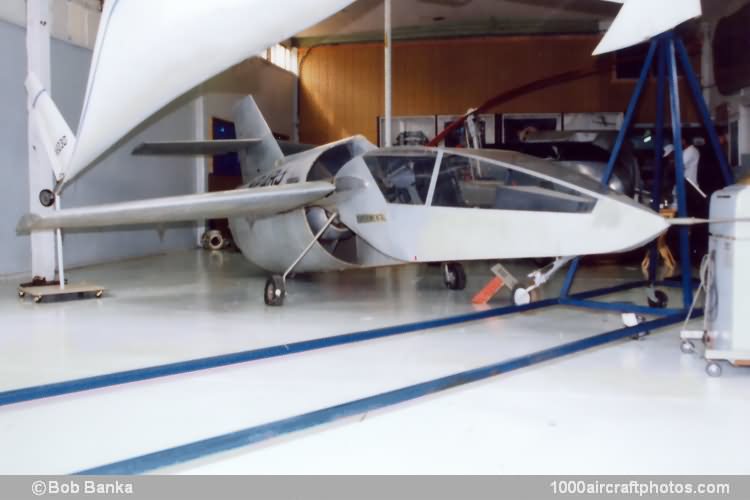06/30/2010. Remarks by Johan Visschedijk: "In the spring of 1975 vague rumors of a jet-like all-aluminum aircraft making low altitude tests at Mojave Airport, California began to surface. And an unfamiliar name in the homebuilt aircraft field became connected with the project-George Richter. As details of the aircraft became clearer it was apparent that Richter was not afraid to break new ground. Nearly every feature of the design was novel and gave the appearance of careful integration. Yet by 1980, the Ric Jet 4 had been retired to the Chino Air Museum and had sunk back into obscurity.
The Ric Jet 4 was never well publicized in the 1970s and many of its features have been garbled by word of mouth, It was not a successful project overall, but Richter's layout showed a good understanding of the differences between ducted fan aircraft and turbojets and shared a number of characteristics with the successful Rhein-Flugzeugbau ducted Fan Trainers of the following decade. His fan or "contained propeller", incorporating an unusually large gap between the fan tip and the inner wall of the duct, seemed heretical to formally trained designers.
Richter had drawn from his extensive experience as a modeler. A series of sub-scale models were built to tryout different plan forms. The Ric Jet 4 was based upon Richter's interpretation of the results of the model series. By July, 1973, the basic framework of the Ric Jet 4 was complete and on the gear. Engine placement and skinning followed as time and finances allowed. The finished product was a striking aircraft with a polished aluminum finish marred slightly by inexplicable patching and fairing of gaps with aluminum duct tape.
From a distance, the Ric Jet 4 gives the appearance of a single-seat sailplane pod melded with an aluminum barrel, a mid-wing and high cruciform tail. The landing gear is tricycle and fixed. The intake into the large diameter duct is carefully faired at the back of the pod, but the lips of the duct lack the inner radiused edges or bell-mouth usually found in ducted fans with high static thrust. A large engine access hatch is present on the starboard side of the duct allowing inspection and maintenance of the engine and fan via hinged panels in the center line pod.
The fan unit consists of a tractor-mounted Mazda RX-2 automobile engine direct-driving a two-bladed 40 in (1.02 m) diameter wood propeller via an aluminum extension shaft replacing the original engine flywheel. A nicely streamlined pod encloses the engine and muffler, The propulsion package is supported concentrically by struts which incorporate flow straighteners aft of the propeller and provides vertical structural connections with the tail unit, a function that the after spar of the wing provides on the horizontal axis. To help in balancing the loaded aircraft, a battery box was located in the extreme nose forward of the instrument panel.
The wings have marked sweep back and anhedral, and incorporate full-span slotted flaps. Spoilers are substituted for ailerons. The wings fold upward at their junction with the duct for hangaring and ground transport on a trailer. They are fabricated like the rest of the airframe from pop-riveted aluminum tube, channel and sheet.
Trial flights in ground effect were useful in confirming several of the Ric Jet's features. The spoilers worked well for lateral control. The aircraft's split rudder and large swept fixed surface fairing into a ventral strake was apparently large enough to ensure good low speed control in yaw. Wheel shimmy was eliminated and alignment of the landing gear was corrected. General ground handling characteristics were good.
The engine was located directly on the CG and overall stability of the aircraft was deemed acceptable. A pad was provided at the bottom rear of the duct as the aircraft rocked back when the pilot exited the cockpit. It was assumed that further trials would resume when a more powerful engine and a new propeller became available. It never happened, the aircraft sat for years, then was donated to the Chino Air Museum in the early 1980s."
